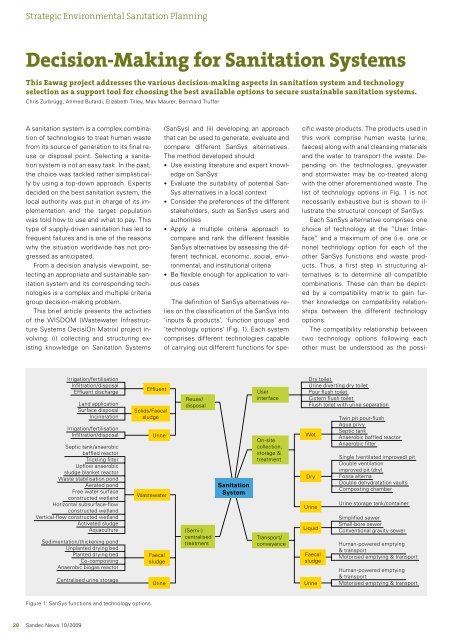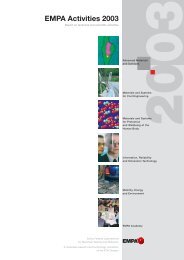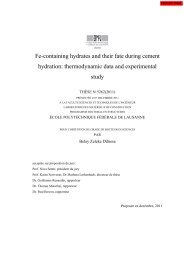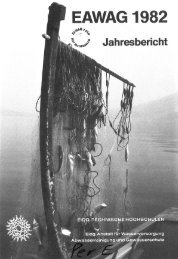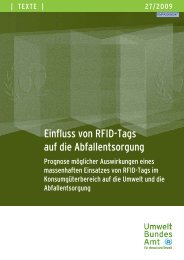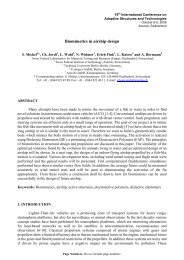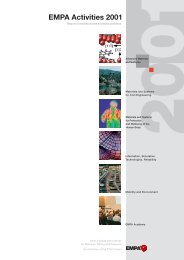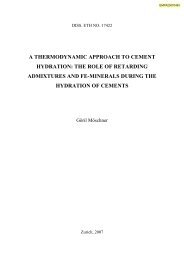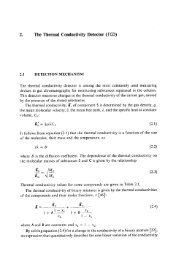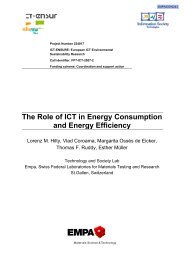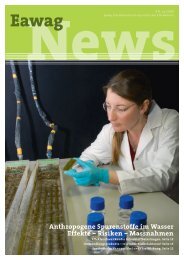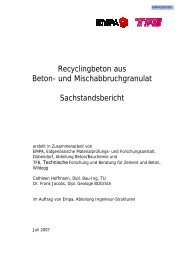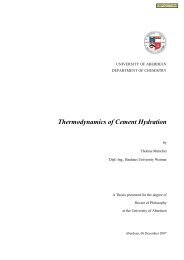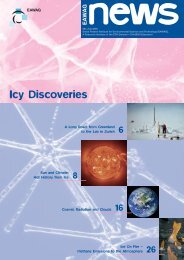Sandec - Eawag
Sandec - Eawag
Sandec - Eawag
Create successful ePaper yourself
Turn your PDF publications into a flip-book with our unique Google optimized e-Paper software.
Strategic Environmental Sanitation Planning<br />
Decision-Making for Sanitation Systems<br />
This <strong>Eawag</strong> project addresses the various decision-making aspects in sanitation system and technology<br />
selection as a support tool for choosing the best available options to secure sustainable sanitation systems.<br />
Chris Zurbrügg, Ahmed Bufardi, Elizabeth Tilley, Max Maurer, Bernhard Truffer<br />
A sanitation system is a complex combination<br />
of technologies to treat human waste<br />
from its source of generation to its final reuse<br />
or disposal point. Selecting a sanitation<br />
system is not an easy task. In the past,<br />
the choice was tackled rather simplistically<br />
by using a top-down approach. Experts<br />
decided on the best sanitation system, the<br />
local authority was put in charge of its implementation<br />
and the target population<br />
was told how to use and what to pay. This<br />
type of supply-driven sanitation has led to<br />
frequent failures and is one of the reasons<br />
why the situation worldwide has not progressed<br />
as anticipated.<br />
From a decision analysis viewpoint, selecting<br />
an appropriate and sustainable sanitation<br />
system and its corresponding technologies<br />
is a complex and multiple criteria<br />
group decision-making problem.<br />
This brief article presents the activities<br />
of the WISDOM (Wastewater Infrastructure<br />
Systems DecisiOn Matrix) project involving:<br />
(i) collecting and structuring existing<br />
knowledge on Sanitation Systems<br />
0 <strong>Sandec</strong> News 10/2009<br />
Land application<br />
Surface disposal<br />
Incineration<br />
Sedimentation/thickening pond<br />
Unplanted drying bed<br />
Planted drying bed<br />
Co-composting<br />
Anaerobic biogas reactor<br />
Centralised urine storage<br />
Solids/Faecal<br />
sludge<br />
Figure 1: SanSys functions and technology options.<br />
Urine<br />
Wastewater<br />
Faecal<br />
sludge<br />
Urine<br />
(SanSys) and (ii) developing an approach<br />
that can be used to generate, evaluate and<br />
compare different SanSys alternatives.<br />
The method developed should:<br />
• Use existing literature and expert knowledge<br />
on SanSys<br />
• Evaluate the suitability of potential San-<br />
Sys alternatives in a local context<br />
• Consider the preferences of the different<br />
stakeholders, such as SanSys users and<br />
authorities<br />
• Apply a multiple criteria approach to<br />
compare and rank the different feasible<br />
SanSys alternatives by assessing the different<br />
technical, economic, social, environmental,<br />
and institutional criteria<br />
• Be flexible enough for application to various<br />
cases<br />
The definition of SanSys alternatives relies<br />
on the classification of the SanSys into<br />
‘inputs & products’, ‘function groups’ and<br />
‘technology options’ (Fig. 1). Each system<br />
comprises different technologies capable<br />
of carrying out different functions for spe-<br />
Reuse/<br />
disposal<br />
(Semi-)<br />
centralised<br />
treatment<br />
Sanitation<br />
System<br />
User<br />
interface<br />
On-site<br />
collection,<br />
storage &<br />
treatment<br />
Transport/<br />
conveyance<br />
cific waste products. The products used in<br />
this work comprise human waste (urine,<br />
faeces) along with anal cleansing materials<br />
and the water to transport the waste. Depending<br />
on the technologies, greywater<br />
and stormwater may be co-treated along<br />
with the other aforementioned waste. The<br />
list of technology options in Fig. 1 is not<br />
necessarily exhaustive but is shown to illustrate<br />
the structural concept of SanSys.<br />
Each SanSys alternative comprises one<br />
choice of technology at the “User Interface”<br />
and a maximum of one (i.e. one or<br />
none) technology option for each of the<br />
other SanSys functions and waste products.<br />
Thus, a first step in structuring alternatives<br />
is to determine all compatible<br />
combinations. These can then be depicted<br />
by a compatibility matrix to gain further<br />
knowledge on compatibility relationships<br />
between the different technology<br />
options.<br />
The compatibility relationship between<br />
two technology options following each<br />
other must be understood as the possi-<br />
Wet<br />
Dry<br />
Urine<br />
Liquid<br />
Faecal<br />
sludge<br />
Urine<br />
Single (ventilated improved) pit<br />
Double ventilation<br />
improved pit (dry)<br />
Fossa alterna<br />
Double dehydratation vaults<br />
Composting chamber<br />
Urine storage tank/container<br />
Human-powered emptying<br />
& transport<br />
Motorised emptying & transport<br />
Human-powered emptying<br />
& transport<br />
Motorised emptying & transport


